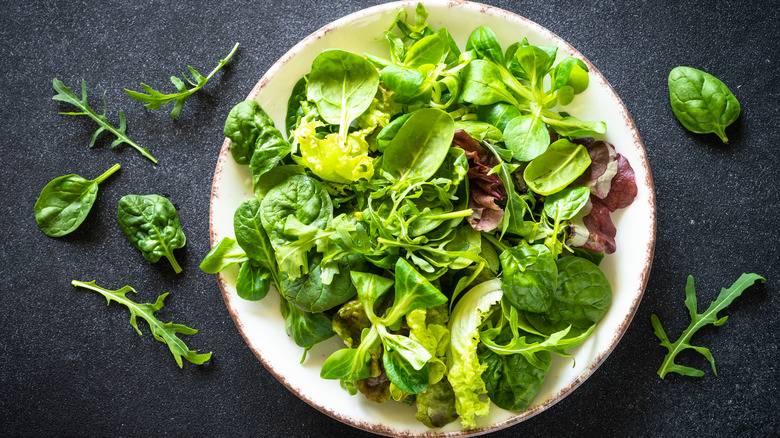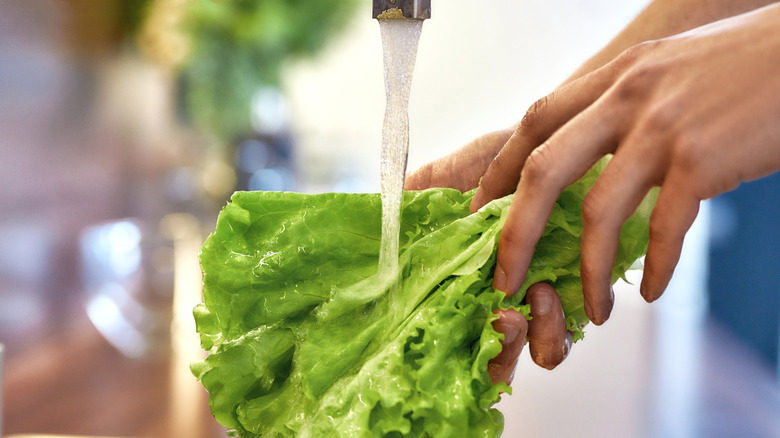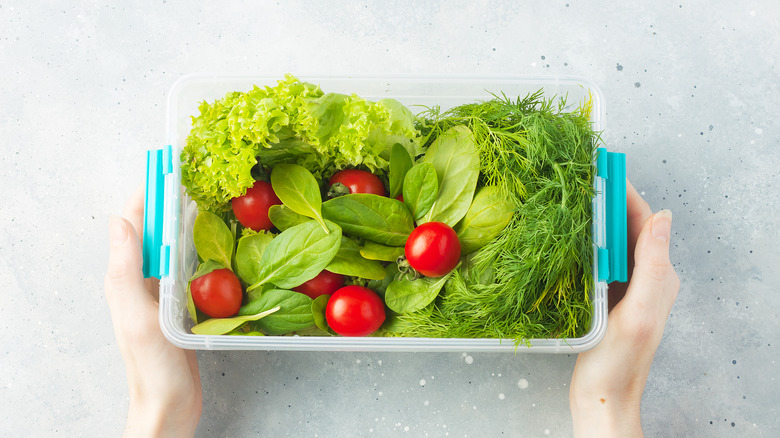Can You Still Eat A Salad If A Few Lettuce Leaves Are Wilted?
It's a disappointment to pull a container of freshly purchased greens from the fridge in the hopes of making a refreshing, crispy salad, only to discover a wilted, slimy mess instead. Luckily, accidentally eating wilted lettuce will likely not cause any serious harm but, of course, there are some potential exceptions.
Any bacteria your leafy greens might pick up on the way to the grocery store — from how and where they're grown to any rogue animals that might walk through the fields — could cause the produce to go bad. Once the bacteria that spoils food begins to multiply, the other bacteria that can cause serious illness (i.e. pathogenic bacteria like E. coli) will likely do the same.
For the most part, if a few leaves are slimy while the rest are holding up, it's probably safe to pick out the bad and eat the good. However, if more than half of the greens are icky, it's best to toss the whole bunch. Most wilted greens can be attributed to age, so make sure to check the expiration date at the store before you make your purchase.
How to wash your greens
Over time, the bacteria already present on your salad greens may spread, so it's important to properly prep your produce to remove anything that may have traveled from the farm to your table. Discard any discolored or damaged leaves before soaking them in cold water, and feel free to swish the greens around to loosen up any extra rocks or dirt. Rinse the greens by running them under cold water and dry them thoroughly by patting them with a paper towel or by using a salad spinner. The drier they are, the less likely bacteria are to spread and cause decay.
Simply washing produce can't remove all bacteria, but it's always recommended as doing so greatly reduces contamination (per the USDA). Want another layer of protection? Vinegar can also be used to deep clean broccoli, and the same technique can be applied to greens. Use a vinegar soak to remove any excess dirt or residue by combining one part vinegar with three parts water in a bowl and letting the produce soak for about two minutes; when that's done, rinse everything with fresh water.
Make leafy greens last longer in the fridge
Extending the shelf life of your greens depends on moisture and airflow; while too much moisture can cause greens to rot, too little can make them dry and sad. Prepackaged bags of salad, for example, tend to rot quickly because of excess moisture trapped by the plastic bags, but salad greens still need some moisture to maintain their freshness. The best storage methods will strike a balance between the two. However, heads of lettuce, such as romaine or iceberg, last longer in the fridge when they remain unwashed and attached to the head. Just make sure you remove any damaged outer leaves and keep the whole thing dry.
When packing greens into a container, layer things loosely to ensure maximum freshness. Simply lay the greens out on paper towels, which you can then loosely roll and place into a bag. This is the same spinach storage technique you can use for added freshness. Spinach can last up to a week in the fridge when stored in this way. You can also use your SodaStream to actually keep salad greens fresher longer with a little help from CO2. Doing so may help keep your greens fresh for twice as long.



